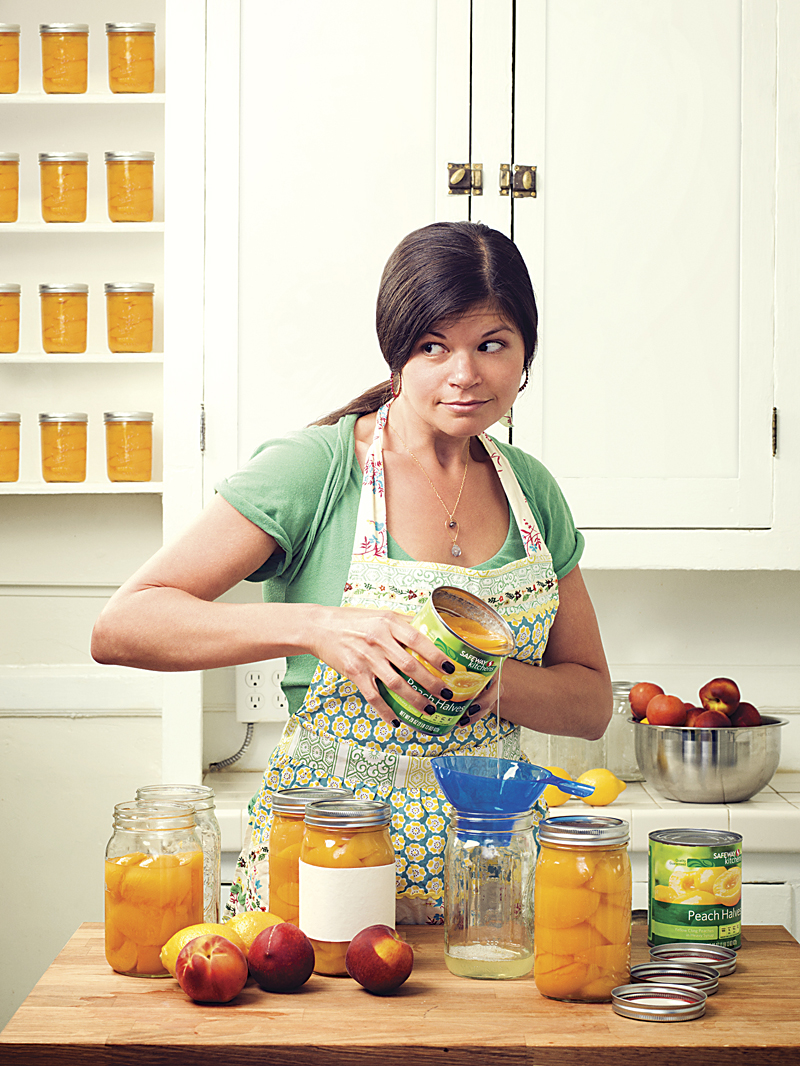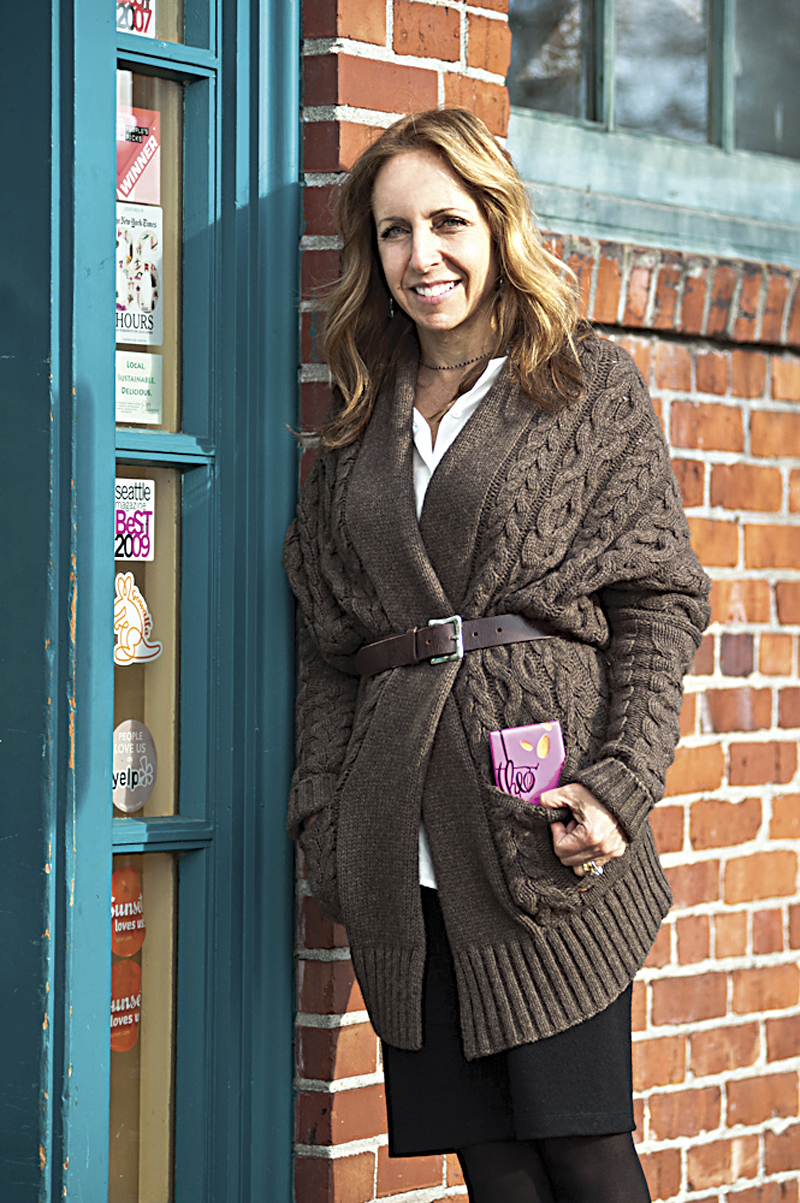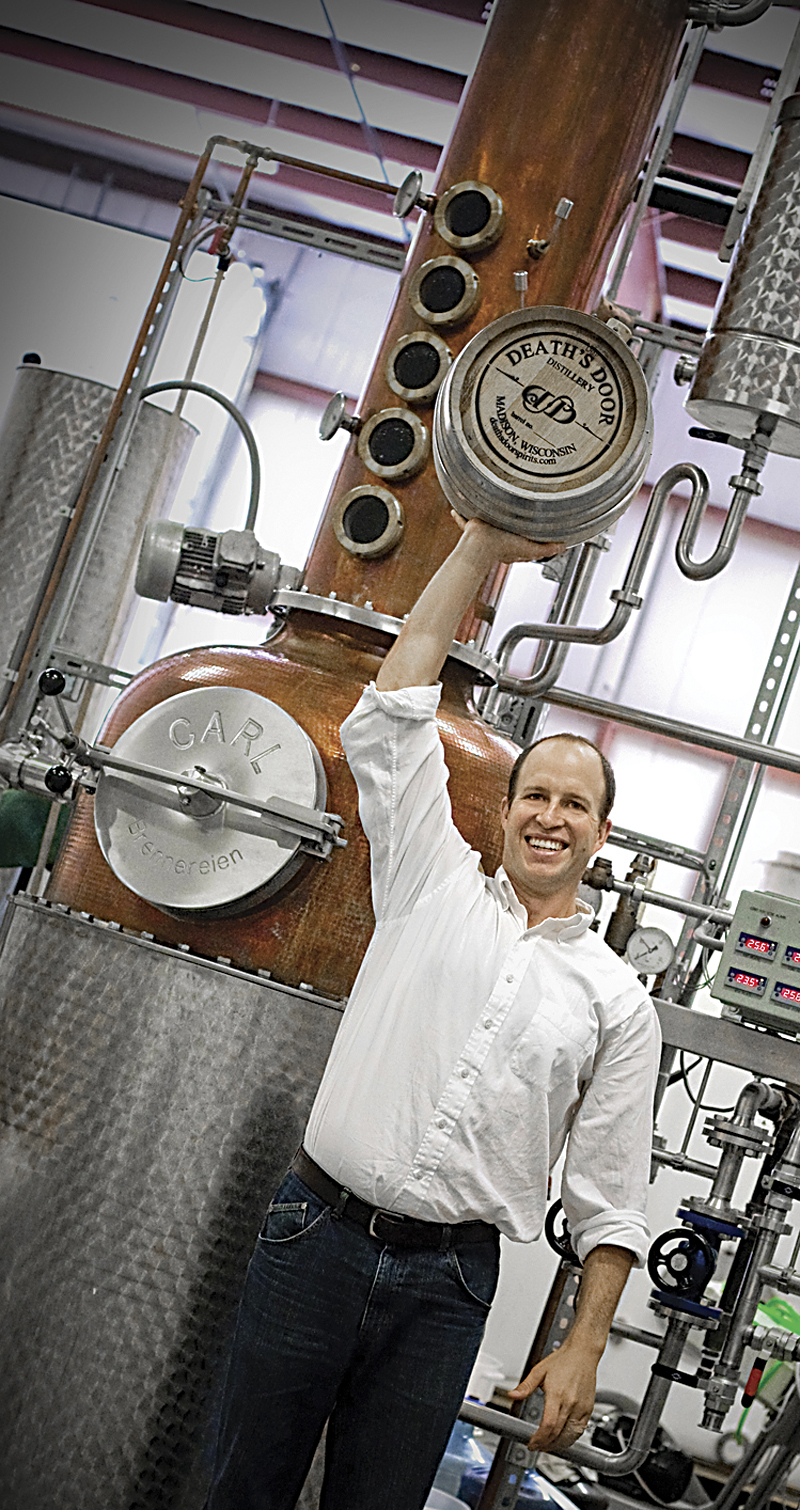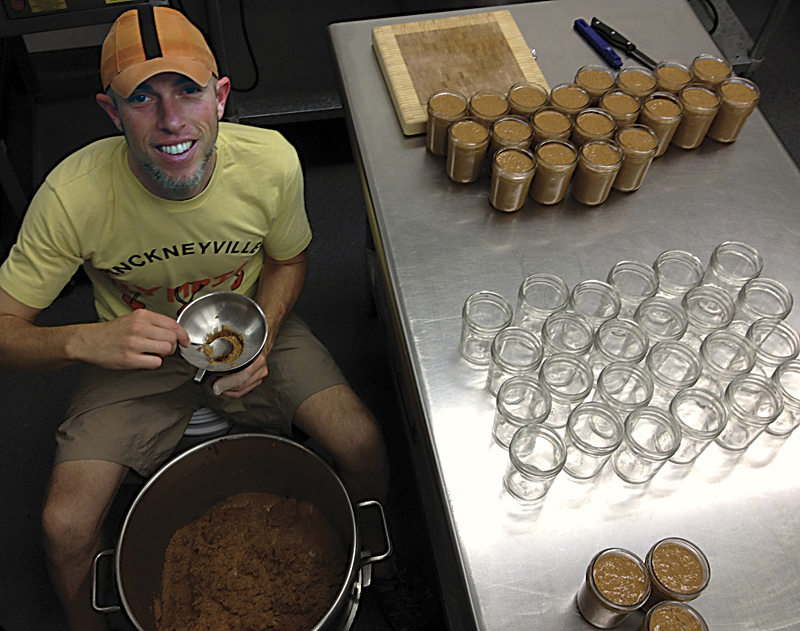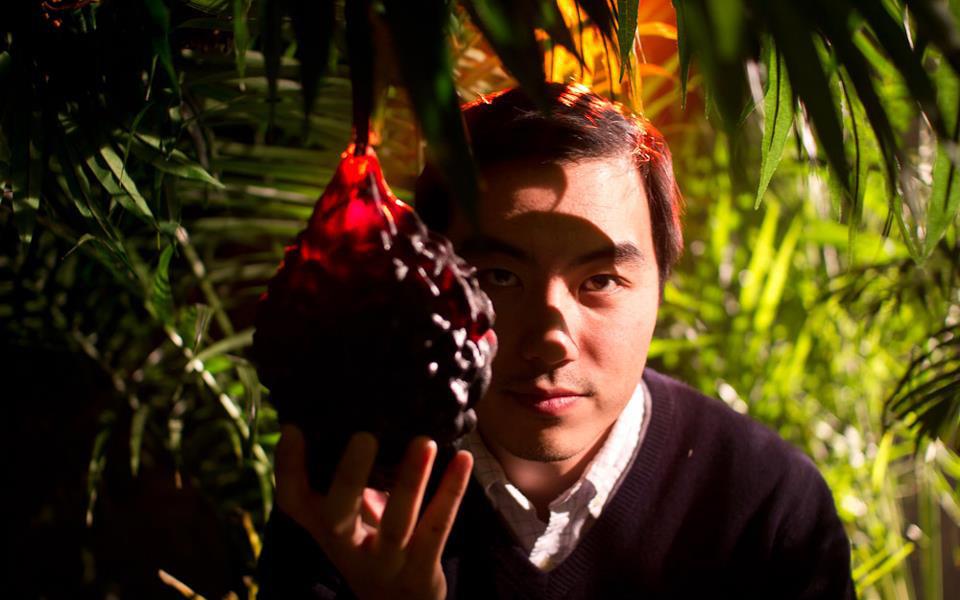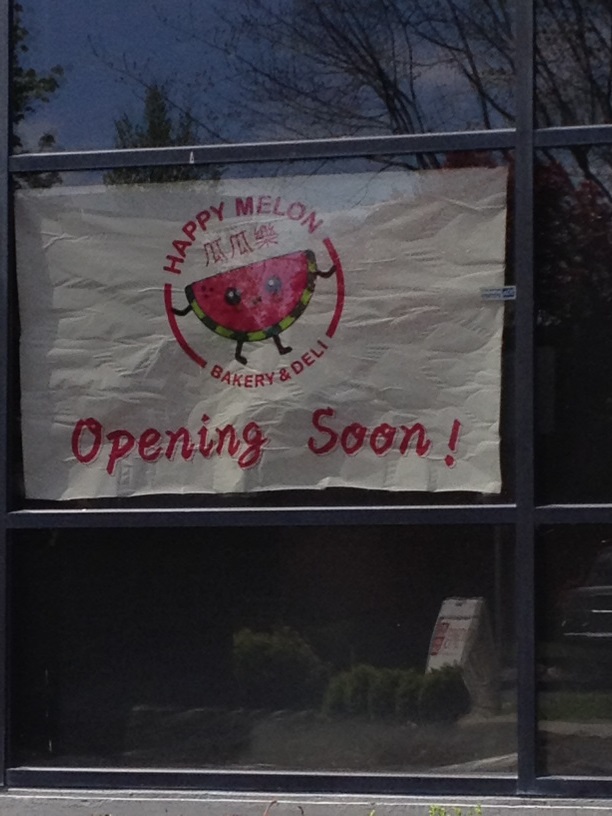If a hard freeze in April hadn’t annihilated northern Michigan’s tart-cherry crop, a little boy in Beijing might have been pouring Herkner’s Original Cherry Topping over his mung-bean ice cream right now. But the fickle weather forced Lynda Herkner, 74, and her sisters to delay plans to export their siren-red dessert goo—”It tastes like a fresh cherry pie,” Herkner beams—and focus on their domestic successes. In the three years since they committed their family recipe to 16-ounce jars, the Herkners have placed their product in restaurants, specialty shops, and one of the state’s biggest grocery chains.
“It’s been a wonderful ride,” Herkner says. “We’re really going. We want to be a Smucker’s.”
The Herkners first sold their topping in 1962, when former President Eisenhower invited their father to join a delegation of farmers headed to Russia on a goodwill program. Ozzie Herkner discarded the letter, knowing he couldn’t afford to travel halfway around the world to chat with collectivists. But after his wife, Etta, found the invitation in the trash, she insisted on opening a “Get Ozzie to Russia” stand on the edge of their cherry orchard. A photograph of the Herkner girls in shirtwaist dresses, leaning out of the booth with their double-crust pies, ran in newspapers across the country.
Lynda, Sue, and Mary Jean sold 1,000 pies, bread, cherries, and a smattering of the dessert topping concocted by their parents, owners of the second-largest cherry farm on the Old Mission Peninsula, a fertile jut of land that now gets by on wineries and weddings. The elder Herkners believed they could sell even more topping, but were stumped by scaling. “They really wanted to market it, but they couldn’t multiply the recipe,” Herkner recalls.
Thus the topping remained a housebound treat. But when Lynda Herkner’s retirement schedule soured after 28 years in the real-estate business, her sisters decided to revisit the family recipe’s windfall potential. “They got to worrying about me,” Herkner says. After a gangbusters consultation with a chemist, the Herkners started buying up Michigan cherries and signed a contract with a co-packer. They’ve since outgrown their co-packer twice.
Despite the Smucker’s-sized aspirations and reliance on outsourcing, the Herkners consider themselves artisans. “We have an excellent product that’s all-natural and all-Michigan, except for the pure almond extract,” Herkner says. “And we started out as small as you can start.”
The word “artisan” has never had a clear definition, although most producers agree it’s somehow intertwined with tradition and quality. But now the term is being stretched like saltwater taffy, and its limits are being closely monitored by food producers who have to make immediate decisions about if, when, and how to grow their endeavors without dishonoring the principles that first led them to the kitchen. Few artisans are vocally doctrinaire; none of the dozens interviewed for this story were willing to attach their names to the questions they raised about the legitimacy of mechanized equipment, co-packing arrangements, and corporate backing. Perhaps because media depictions of artisans aren’t always flattering, they perpetually emphasized their support of fellow producers’ choices.
But the field remains unsettled. When determining the size and scope of their businesses, artisans must place such unwieldy concepts as beauty, social justice, heritage, sustainability, and taste on opposite sides of the same scale. The process has exposed a gamut of intellectual, geographic, and economic tensions in a community reluctant to acknowledge conflict.
“I just went to Japan and was totally charmed by people like the ninth-generation knife maker who makes only 70 knives a year and the eighth-generation chopstick maker who personally lathes all of the cedar chopsticks,” says Nathalie Jordi of People’s Pops, which makes ice pops and shave ice from fresh herbs and fruit. People’s Pops recently purchased a packaging machine so Jordi and her partners can spend time previously squandered hand-sealing bags on sourcing fruit and testing new flavors. “The stories are priceless, and you can’t help but feel infinite respect for people who dedicate their lives to mastering a craft,” Jordi says. “It’s a beautiful and a special thing. It just doesn’t happen to be what our goal is at People’s Pops. I’m more driven by visions of public-school kids someday eating pops made with actual fruit. To me, that’s beautiful and special, too.”
People’s Pops is based in New York City, but Jordi’s pragmatism reflects the artisan approach that’s taken hold beyond the urban centers commonly associated with thoughtful food. Herkner, for example, concedes she doesn’t look much like the stock artisan caricature, with his porkpie hat, waxed mustache, and bicep tattooed with a 19th-century etching of a pickle press. But as those earnest San Franciscans and Brooklynites scuffle over the meaning of artisanship, Herkner and her sisters are charging headlong toward the goal of changing the way their fellow Michiganders eat.
Matt Birbeck of Michigan State University’s Product Center for Food confirms that the Herkners’ confection is habitually luring shoppers away from industrially produced ice-cream sauces made with high-fructose corn syrup and red dye #40, although Herkner’s quick to mention that the sauce is equally good atop whitefish or beef. “When I got here, seven years ago, it was like value-added, ha, ha,” Birbeck says, using the industry term for a farm product that’s taken a transformational trip through a kitchen. “Now we’re on a roll. It’s suddenly taken off.”
The topping’s popularity has also reawakened interest in cherries, a crop so devalued in recent decades that a 10-acre oasis surrounding Herkner’s sister’s house is all that remains of the once-sprawling Herkner family farm. Herkner is confident that her parents’ recipe can help shield other northern Michigan farms from the same fate. “By promoting the cherry, we’re keeping the cherry in your face,” she says. “We feel we’re promoting the cherry farms here.”
Very few big-city artisans mess with frozen fruit and co-packers, linchpins of the Herkners’ ambitious business plan. Although small-scale producers defend their choices as quality-driven, many of them privately admit they’re fearful that other artisans will dismiss their work if they don’t personally slice their fruit and stir their pots.
“I’ve heard other jam makers say that using a co-packer ‘doesn’t feel very artisan,’ so I worry that I’ll be turned out of the artisan club if I consider that option—even though our local co-packer is pretty hands-on and I would be present,” says Rebecca Staffel, who uses the term “artisan” to market the award-winning preserves she sells under the Deluxe Foods label. “We recently bought a big chopper for our rhubarb and apples. Does that mean I can’t say the jam is completely handcrafted anymore? I worry about the shocking exposé sometimes.”
Staffel is trying to find smart ways to grow her Seattle company. But plenty of talented chutney makers, kombucha technicians, and mustard mixers are deliberately keeping their businesses as tiny as the market will allow. They painstakingly sink local asparagus spears into brine perfumed with lavender blooms, and hand-grind organic, fair-trade vanilla beans for cocktail bitters, a bottle of which sells for three times the price of a Bud Light six-pack.
“It’s totally obnoxious, because there’s no cultural relevance,” says Joe Schroeder, who helps North Carolina farmers translate their crops into artisan products.
Still, artisans’ self-absorbed antics have succeeded in attracting outsized attention. Portlandia and The Daily Show have loudly poked fun at hipsters’ reverence for vinegar and local quince, and a recent New York Times feature derisively quoted an artisan groupie who “doesn’t care” whether or not Koreans actually eat tacos, so long as the kimchi-salsa maker has a good story to share.
Yet while the noun “artisan” is ripe for parody, the adjective has somehow managed to acquire commercial cachet. Domino’s, Sargento, Tostitos, and Dunkin’ Donuts have lately tagged their pizzas, shredded cheese, chips, and bagels with the label, well aware that sales of specialty food products shot up 19 percent between 2009 and 2011. Empire Mayonnaise, an emblematically precious Brooklyn outfit, can only make its black-garlic spread in exceptionally limited quantities, but the desire for authentic, handcrafted excellence has clearly trickled down to those who can’t buy the mayo.
In the South and Midwest, food producers are taking full advantage of the opportunities their angst-ridden, tale-spinning brethren on the coasts have helped create. They’re salvaging generations-old recipes, buying raw ingredients from farmers desperate for new income sources, and selling the results to eaters suddenly hungry for food that isn’t assembled in a faceless factory overseas. “They’ll buy something like ours compared to something commercial any day,” Herkner says.
Far from the heated “pickle wars” that North Brooklynites swear is the creation of excitable food bloggers, the heartland’s artisans are calmly and subtly steering the nation’s food system in the direction that makers of nitrate-free chile lime jerky and vegan foie gras wish it would go.
The notion of artisan food isn’t new. When in 1842 Messrs. Hughes and Potter of New London, Conn., alerted People’s Advocate readers to “a superior article of root beer” which they intended to deliver “fresh and pure” by cart to subscribers, or when Mr. Kimball of New York City announced in an 1831 issue of the Evening Post that he’d produced rosewater “for imparting a flavour to conserves” that was “entirely free of any artificial compound,” they were appealing to their prospective customers’ appetites for clean, safe, individualized food. Some of the earliest artisans’ names survive on products first devised as high-quality, small-batch antidotes to perceived shabbiness in the standard food supply: Edmund McIlhenny, Jim Beam, Domingo Ghirardelli, and J.M. Smucker’s products can now be found in most grocery stores.
Yet “artisan” as a culinary come-on is a fairly new addition to the common lexicon. “I’m trying to remember if that was a word in 2007 when I started my business,” says April McGreger, a respected pickle and preserve maker based in Hillsborough, N.C. Until the turn of the current decade, artisans were usually people who stitched leather bracelets or threw clay pots. But the term started to creep into food conversations via cheesemakers and bread bakers, who used the phrase on business cards and cookbooks as early as 2000. Artisan food “is made by hand using traditional methods,” the San Francisco Chronicle explained in a 2009 story headlined “What is artisanal food?”
Once in circulation, the word was flypaper for publicists and book publishers, who this year plan to release The Artisan Soda Workshop, Artisan Vegan Cheese, An Essential Guide to Artisan Meat, Artisan Pasta, and The Artisan Marshmallow, among other artisan-oriented titles. As nebulous food terms go, though, “artisan” is still not nearly as familiar as “organic” or “local.” A 2011 study by the National Association for the Specialty Food Trade (NASFT) found that 26 percent of specialty-food consumers seek out artisan products, compared to the 55 percent who gravitate toward organic labels. A mere 1 percent of shoppers who don’t regularly buy specialty foods say they care whether they’re buying artisanal, and organizers of the Good Food Awards, a 2-year-old project to recognize the nation’s finest artisan foods, estimate that half of 1 percent of food purchases could be classified as artisan.
The numbers may be paltry, but NASFT’s vice-president Ron Tanner thinks they’re promising. “The people who are really driving this are people in their 20s and 30s,” Tanner says. “It’s people who grew up drinking Starbucks. If you’ve been eating good cheese, you’re not going to start eating Velveeta.”
Although older consumers may not want to spend an extra dollar or two on handmade salsa, Tanner says “artisan” evokes overwhelmingly positive associations from eaters of all ages, which helps explain why major food companies are increasingly using the word “artisan” as a synonym for “tasty.” Domino’s Chris Brandon says the pizza maker last year branded its new line of thin-crusted rectangular pies as “artisan” in a “tongue-in-cheek way,” but makes clear the company’s rationale wasn’t as flimsy as the transparently fake Sicilian backdrops used to advertise its $7.99 pizzas. “[We’re] getting across how special these pizzas are,” he says. “We are serious about the quality of these pizzas.”
Dunkin’ Donuts advanced a similar argument this spring when it launched its artisan bagels, a collection that includes a sun-dried-tomato bagel smeared with reduced-fat spinach-and-artichoke cream cheese. According to its TV commercials, artisan is “Latin for really, really good.”
Unamused, Marc Fintz of Davidovich Bakery in Queens filed a complaint this spring with the Federal Trade Commission, which currently defines “artisan” only in relation to American Indian art and has a policy of not commenting on ongoing investigations. “Artisan isn’t an adjective, it’s an action verb,” Fintz says. “From our perspective, artisan means you adhere, as much as possible, to traditional methods of the origins of your product. Dunkin’ Donuts has taken a position that’s immoral, deceitful, and wrong.”
Fintz’s understanding of artisanship hinges largely on scale and speed. If manufacturing equipment is moving faster than a human being can comprehend or control, the end product can’t be called artisan. He cites Wonder Bread as the ultimate not-artisan baked good. “If you took a look at every slice, it’s the same,” he says. “Let’s understand what it is: It’s a chemical product, it’s a commercial product.”
Fintz says bakers across the country have thanked him for representing their interests, but the staunchest artisans might wonder if his outrage amounts to the pot calling the bagel kettle black. Davidovich Bakery is very much a commercial operation, turning out 25,000 bagels a day. As the wholesaler picks up more of failed bagel giant H&H’s former accounts, it plans to increase production to 40,000 a day. While Davidovich uses hand-rolling techniques that wouldn’t fly at a Hostess factory, it also doesn’t conform to the technological restrictions that some artisans devoutly observe. “We use machinery for mixing,” Fintz says. “We don’t mix by hand. We use ovens. We’re not firing bagels over an open fire, obviously.”
By reputation, the most rigorous artisan in the country is June Taylor, the legendary San Francisco marmalade maker who studied domestic science as a north London high-schooler in the 1960s. Jam makers rarely describe their methods without invoking Taylor’s name: When they confess they’re considering leaving a kitchen in a manager’s care or purchasing candied orange peel, they reflexively say that “June Taylor wouldn’t like it.”
“Everyone makes their own decisions,” Taylor allows. “I’m not sitting here in judgment. I hand-make to the highest degree. I’m in there with my knife, I’m slicing my fruit. I guess there’s a scale issue for me with artisanship: We cook a pot’s yield. We’re not using commercial pectin. We’re very personally committed to our fruit.”
For Taylor, artisanship implies intimacy. A true artisan is present at—and, ideally, involved in—every stage of a product’s development. “I’ve just been to the city to pick up letterpress labels,” Taylor says. “It’s a key concern, paying a lot of attention to aesthetics of food and presentation.”
McGreger is slightly more flexible on matters of slicing; she’s installed a Robot Coupe in her kitchen so she can efficiently chop cabbage for her Farmer’s Daughter krauts. But she interprets “artisan” much as Taylor does. “I’m judging and tasting, using all of my senses every day,” McGreger says. “I’m using a lot of experience and intuition. I’m not just using a probe. It’s a lot more human than that. It’s something you learn and craft over time.” The Robot Coupe, she adds, will never process plums for her cardamon jam or figs for her preserves. “We never run fruit through it,” she says firmly. “Those shortcuts lead to a degradation of quality. Our goal is that every batch is the best batch we ever made.”
Dealing in superlatives comes with a cost, as Taylor and McGreger readily acknowledge. “I know my work is not affordable for a lot of people,” Taylor says. “That’s a reality I had to accept and make my peace with. That’s sad, because I don’t have requirements that anyone buy from me regularly, but to be awakened to quality, that’s what’s important to me.”
Taylor charges $14 for an 8-ounce jar of marmalade, conserves, or fruit butter. She’s threatened to title her memoirs A Jar of Jam in honor of the countless exchanges at the Ferry Plaza farmers market—and, perhaps less frequently, in her Berkeley shop—that have begun with a customer exclaiming “Fourteen dollars? For a jar of jam?”
“People don’t necessarily want to put $8 jelly on their kids’ PB&J. I get that,” says McGreger, who prices her jams and preserves at $1.50 an ounce. “But the whole elitist argument has never, ever resonated with me because my family is from total humble beginnings, and we always cared about food and spent money on it. Now we all spend $100 a month on cell phones. Everyone has cable. It’s insane.”
The economics of artisan food are more worrisome to Dan Rosenberg, owner of Real Pickles in western Massachusetts. Rosenberg and his wife Addie started pickling 11 years ago. “I wanted to help bring traditional pickles back into the American diet,” he explains. “When I started the business, I was a big believer in small business. My idea was ‘I’m just going to grow this until I can make a decent living.’ We’ve doubled from that, and we still need to grow a little bit more.”
On average, Real Pickles daily produces 400 jars of pickles and sauerkraut in its 12,000-square-foot kitchen. Rosenberg puts far less emphasis on the laying-on of hands that some artisans espouse: Cases of beet kvass and ginger carrots routinely get made without his help. “Addie and I are hardly ever in the kitchen at this point, and I would say we’re still artisans,” he says.
An active participant in the Occupy movement, Rosenberg believes his presence is secondary to his philosophy. “Very fancy food has its place, but my personal incentive is for artisans to bring good food to everyone. It’s really important for us to keep affordability in mind.”
That principle nearly doomed one of Rosenberg’s favorite pickled products. Dilly beans—which had a brief fling with fashionability in the early 1960s, when Manhattan cocktail-hour hostesses discovered they made fine martini garnishes—serve as a garden-surplus solution across the country, but are especially popular in New England. The recipe for dillies is so simple that it’s often taught in introductory canning classes, but the green beans were a sticking point for the Rosenbergs: The organic farmers around Greenfield, Mass., hand-picked their string beans, driving up the bushel price. When Rosenberg did the math, he realized he’d have to sell his dilly beans for $12 a jar.
“There are definitely some people who would pay for them, but it didn’t feel right to us,” Rosenberg says. “Other businesses might make that choice. For us, it would not be a match.”
The Rosenbergs recently hooked up with a nearby organic farm that mechanically harvests its beans, allowing Real Pickles to offer organic dillies fermented with Northeast-grown garlic and dill for $6. But the beans are just one chapter in an epic treatise on quality and social responsibility: Food artisans are constantly negotiating ways to source ingredients that stay true to their aesthetic and moral beliefs. As they finalize their recipes, they face the same decisions that confront ethical shoppers at the supermarket: organic or local? Should they buy the jalapeños harvested by formerly homeless veterans, or choose the most delicious peppers, regardless of who benefits from their sale?
“In our world, quality and integrity are inherently linked to each other,” says Deb Music of Seattle’s Theo Chocolate, the nation’s first organic and free-trade chocolate factory. Theo’s image as a global good guy is so ingrained that Ben Affleck partnered with the company to promote economic development in the eastern Congo, while the Jane Goodall Institute and World Bicycle Relief both have branded Theo’s dark-chocolate bars.
“For us, there’s no luxury in a product that’s damaging to the environment,” Music says. “It’s even a little more nuanced: I think every product needs to be produced in a way that’s beneficial to someone or something.” She isn’t ready to require every small-scale food producer to work toward social justice, though. “Someone who wants to create something beautiful, that’s a noble effort,” she says. Whether those producers should be welcomed into the artisan fold, though, is a question that an incipient national association of food artisans—the first-ever such group—will soon be forced to answer.
Having to balance craft and community is a task peculiar to food artisans. While winemakers are generally fluent in sustainability and land stewardship, very few drinkers ask sommeliers to recommend something from a community-oriented vineyard to go with their duck confit. That’s because while quality is primal in the wine industry, many mustard makers and muffin bakers explicitly launched their businesses as a means of reforming an industrial food culture rife with worker abuses, animal mistreatment, and unhealthy chemicals.
“We believe in capturing the bounty of the peak growing season and bringing it to folks who might not have the knowledge to preserve food themselves,” announces the website for Suddenly Sauer, a tiny pickling operation that leads fermentation workshops for inner-city cooks. “Tapping into urban farming projects in Detroit, Suddenly Sauer uses chemical-free produce grown by farmers we know and trust.”
In their zeal to offer homespun alternatives to processed food, a few artisans have made decisions seemingly at odds with their stated goals of making everything better for Joe Q. Eater. Following the example set by bootstrap farms and restaurants, pickle makers and distillers—such as Seattle’s Firefly Kitchen and Woodinville Whiskey—regularly staff their bottling and labeling sessions with volunteers, in clear violation of labor laws intended to protect workers. And it’s not uncommon for newly declared artisans to flout critical health-department regulations.
“When I started this, I just started playing around,” says Anton Nocito, who makes lovage and sarsaparilla soda syrups in Brooklyn. Martha Stewart Weddings last year suggested brides tie tags to P&H Soda Co. bottles and present them as guest favors. “It was literally an illegal market in the basement of a church,” Nocito remembers. “A lot of people there were baking cakes, but they brought them and sold them. I started thinking, I need to research how I can do this properly. I maybe think it’s not so cool to be producing out of your apartment that has a cat hanging around. There’s a lot of people who don’t follow the rules. It’s probably a lot of times they don’t know better. It’s growing so rapidly that a lot of the information that should be out there isn’t getting out there quickly enough.”
Of the 130 artisans selected as finalists for last year’s Good Food Awards, five were disqualified for violating competition standards. “They weren’t able to trace where their ingredients came from,” director Sarah Weiner says. It’s unclear whether the scofflaws were so caught up in the artisan craze that they figured there was easy money in a Good Food Awards gold seal (a fundamental misunderstanding of the industry, warns Dafna Kory of San Francisco’s Inna Jam: “It’s not a get-rich-quick scheme. It’s a work-with-no-money scheme”), or if they were genuinely confused by rules governing fungicides and gestation crates. Banking on the latter, Weiner’s San Francisco–based group is planning soon to roll out the Good Food Guild, an umbrella organization for the hundreds of unaffiliated artisans who yearly enter the awards competition in the hope of scoring a win and a congratulatory kiss on the cheek from award-ceremony presenter Alice Waters, the chef/owner of Chez Panisse and an acknowledged figurehead of the sustainable-food movement.
“What we’re going to do is connect and promote the whole industry,” Weiner says. Guild members will be eligible for educational programming and collaborative marketing opportunities, including a massive trade show timed to coincide with the awards celebration.
In drafting its membership criteria, the Guild has been forced to formalize its values, a few of which created regional conflicts when they first popped up in the awards process. “For example, initially we required cheesemakers to certify that organic feed and grass were the only thing their cows were eating,” Weiner says. “We received thoughtful objections on this point from the Southern Cheesemakers Guild and several Southern cheesemakers. It is much harder for them to source organic feed in the South than here in California, though many are using locally grown and certainly pushing the envelope on artisan cheesemaking in the South.”
So the word “organic” doesn’t appear in the Guild’s guiding principles—which are grouped into categories labeled “tasty,” “authentic,” and “responsible”— but members are still forbidden from using synthetic fertilizer, pesticides, or herbicides, a prohibition which strikes some producers as a California affectation.
“We use conventional pesticides,” says Portia McKnight of Chapel Hill Creamery, a 37-acre dairy that’s known in North Carolina for its elegant interpretation of Camembert. “We feel it’s the best situation for our cows. When you’re actually farming, when your neighbor is also farming, you know they’re not evil because they’re spraying herbicides. They think conventional farming is the enemy, and I don’t have that perspective at all. I think anything protecting farms is doing something valuable for our future.”
McGreger, who sells alongside McKnight at the Carrboro Farmers Market, agrees: “It’s not just about a high-quality product. It’s bigger than that,” says McGreger, who worked her family’s sweet-potato fields as a girl in Vardaman, Miss. “I feel like wildness is one of our values. Supporting local agriculture. Preserving local land, that’s a big part of it. To certain people, the things I’m saying are really political, but they’re values my grandfather had, and to him it wasn’t political.”
The Good Food Guild calls upon its members to make food that’s “an expression of tradition and culture” and to “use local ingredients whenever possible,” but doesn’t specifically ask them to agitate on behalf of farms or farmers. Torn between sensuality and advocacy—a tension spotlighted this month when Slow Food USA’s president left the organization after enduring harsh criticism from members who didn’t think the taste-centric club needed to meddle in food-policy fights—the many artisans who prize stories, vintage glassware, and gray sea salt are siding with the former. But for artisans without a built-in customer base ready to buy anything packaged in a darling burlap sack, the raging interest in high-quality heritage products represents an unparalleled opportunity for agricultural activism.
Brian Ellison, founder of Wisconsin’s Death’s Door Spirits, is often asked how he decided to work with Washington Island farmers. But when he launched his company, there weren’t any. “Farming had died off in the 1970s,” Ellison says. “Then in 2005, I found two brothers willing to grow five acres of wheat.”
According to the original business plan, Ellison would use the wheat’s flour to make fancy artisan breads for bed-and-breakfasts in Door County. But he quickly realized there wasn’t any money in baked goods. “Frankly, a salesman doesn’t go home and say ‘I crushed it this week, let’s get the good flour.’ ” In 2007, Ellison started distilling, and “the success was immediate.” Death’s Door’s current annual production is 250,000 cases of vodka, gin, and whiskey, making Ellison the odd artisan who’s become too big to outsource. After years of distilling in Cedar Rapids, Iowa, the company this month opened Wisconsin’s biggest craft distillery. Death’s Door celebrated its grand opening with cocktails and cheese from the Wisconsin Milk Marketing Board.
“From the beginning, my belief was we could find partners for everything,” Ellison says. “It got to the point where we were growing so fast, the feeling was either we have to accept the fact that we don’t get the same quality every time or build a distillery.”
The growth has reconstructed Washington Island. The five-acre stand of hard red winter wheat that a pair of farming brothers first planted for Death’s Door has grown to 1,200 acres of organic wheat planted across the island.
“The best way to keep people farming their land is to have them farm it,” says Ellison, who pays three times the going rate for wheat, chalking up the added expense as a marketing cost. “You don’t need land trusts.”
When cheap imports and antismoking campaigns conspired to decimate North Carolina’s historic tobacco industry, the state’s farmers were left with badly depreciated tracts of land that wouldn’t yield corn or cotton. Joe Schroeder oversees a program that connects farmers with alternate income streams: The Tobacco Communities Reinvestment Project has funded a group of Hmong farmers who are growing bamboo and Chatham County dairy farmers who’ve come up with a mozzarella cheesecake.
“There are a lot of folks, particularly in the foodie, artisanal world, who have a different set of values,” Schroeder admits. “Their value system is still based on cutting every strawberry with a knife in a certain way. From our perspective, it’s all about finding the scale that gives farmers the opportunity to continue farming.”
Leslie Schaller, who works with entrepreneurs in the Appalachian region of Ohio, has a client who’s making ice treats and beer from indigenous pawpaws, a creamy, mango-like fruit sometimes called a poor man’s banana. “He created a whole pawpaw fest, and lobbied so pawpaw is now the state fruit,” she says. “Pawpaw was really considered the garbage fruit of Appalachian Ohio. But [now] it’s an exotic fruit at Wegman’s,” the New York grocery chain so adept at sophisticated display that curatorial students tour its aisles when studying exhibit design.
“There’s a lot of crazy stuff going on in the back of nowhere,” she adds, laughing.
Those projects might not have been possible without the artisan movement, Schroeder says. He points to Felix Vargas, a migrant farmworker who became a citizen and bought land in southwest North Carolina. Vargas is developing a low-sugar passion-fruit jam for diabetic Hispanic immigrants who miss the tropical flavors of Central America. “He doesn’t want to get big,” Schroeder says. “Passion fruit is his niche. He wants to provide access to the food people were used to back in Mexico.”
According to Schroeder, “in terms of seeing jam save the farm, it’s a bit of a stretch,” but agricultural activities have become hugely important in economies battered by factory closings.
“Michigan’s heritage was built on building cars, and we recognized we had to rethink ourselves as a state,” says Matt Birbeck. “We’ve climbed on board with agriculture. Culturally, we’ve changed to understand value-added is sexy.”
Birbeck moved to Michigan from California, where he says artisans are “more focused on cosmetics. Here, we focus on ingredients. When you talk about ‘artisan’ in San Francisco, they’re talking about craft, whereas here it’s taste.”
In addition to the Herkners’ cherry topping, Birbeck has helped develop and market whitefish filets, cheeses, and venison sausages. Since 2004, MSU’s Product Center claims it has officially launched 229 food businesses, creating 917 jobs statewide. Funded by the Michigan Agricultural Experiment Station and Michigan State University Extension, it offers growers and home cooks a menu of services, including market research, label design, and financial planning. Last year, more than 250 entrepreneurs signed up. The center has been so successful that on June 24–26 it hosted the National Value Added Conference in Traverse City, near the orchards where the Herkners’ cherries grow.
“If you are a person who has a recipe in your back pocket and $5 in your other pocket, you can come to us,” Birbeck says. “I think every state has a program like this, but Michigan is really pushing it because it’s an area it can do very well.”
Doing well for Birbeck is measured in dollars, so he’s cut deals with Kroger and Meijer to dedicate shelf space to Michigan artisans. When WDIV, Detroit’s NBC affiliate, this month covered the introduction of Kroger’s “Pure Michigan” section—”This is huge news,” the reporter raved—a marinade maker stationed alongside the display looked slightly dazed from gratitude. “It kind of just blew me away to think I have this opportunity to be in such a prestigious store,” she said.
Birbeck has little patience for the quaint and quirky. “When we can help a farmer, when we can help people who have lost their jobs, that’s what I do,” he says.
Matt Jamie of Bourbon Barrel Foods also works with corporations: Woodford Reserve, owned by liquor giant Brown-Forman, last year hired the Louisville soy-sauce maker to develop a sorghum vinaigrette salad dressing with its bourbon. Jamie recognizes that the partnership qualifies him for sellout status in certain artisanal circles.
“I want to make a lot of money,” he says. “I don’t think there’s a problem with me remaining an artisan. When a company like Brown-Forman approaches you, it opens doors.” Jamie clarifies he didn’t have to sacrifice quality for the contract: “I was approached by QVC, and the guy was like, ‘We’ll make this in China,’ and I was like, ‘You could, but you can’t put my name on it.’ These products are my babies. We’re selling a super-premium product. I embrace that.”
Since Jamie doesn’t grow the sorghum he uses for his salad dressings and syrups, he’s not welcome at his local farmers market. “They don’t want anything to do with me. I’m like no, I’m not growing sorghum, but I buy from one guy. It’s a single crop and he doesn’t have time to come out here and sell.
“I’m not always over the kettle,” he continues. “I’m 50 percent food artisan and 50 percent entrepreneur, maybe even 60/40. I don’t grow sorghum. I don’t have a spring on my property. But I make something artfully.”
Although sorghum once was the region’s dominant sweetener, it’s now largely forgotten outside isolated pockets of the mountain South. Jamie says wedding sorghum to artisan techniques and promotional strategies has helped create new markets for sorghum farmers, who are now forming a trade group.
“The sorghum farmers I buy from would never see an end product,” he says, referring to the more than 75 percent of U.S. sorghum that’s used for ethanol and livestock feed. “So when they saw my product at Williams-Sonoma, they took a picture with it. They saw it on a menu and brought the chef out, they were so proud of what they did. I’m very proud.”
At Big Spoon Roasters in Durham, N.C., Mark Overbay, a veteran of the fair-trade coffee business, makes every batch of his locally sourced nut butters by hand. “I literally scoop the nuts by hand, and spoon the butter into every jar with a tablespoon,” he says.
A lifelong peanut-butter eater, Overbay was inspired to start Big Spoon by the ground-nut harvests he witnessed as a Peace Corps volunteer in Zimbabwe in 1999. “They would shell them and roast them in big pans, or, in one case, over the hood of a car,” he says. “People would bring containers or banana leaves, just whatever they had to take it back in. It was one of the most delicious things I’ve ever had in my life. It was a completely different food experience.”
Yet it’s one which Overbay believes can survive upsizing. “With a smallish nut roaster, I would increase my capacity by 1,000 percent, and then I would simply have to find a larger grinder and maybe a couple of stand mixers,” he muses aloud. But he’s thinking even bigger, because his passion for the exemplary flavors of great nut butter is matched by his passion for reinvigorating peanut farming in the South.
“If I want organic peanuts, the closest place I can get them is New Mexico,” Overbay says. “There’s nothing wrong with New Mexico, but as someone who believes in supporting North Carolina, I made the decision early on to buy North Carolina peanuts. I want to grow our business so we can be a positive market force for sustainable agriculture in the Southern peanut sector. I believe—and I don’t think this is a pipe dream—there can be sustainable, organic peanut agriculture in the Southeast. I want Big Spoon to be an advocate for that.”
